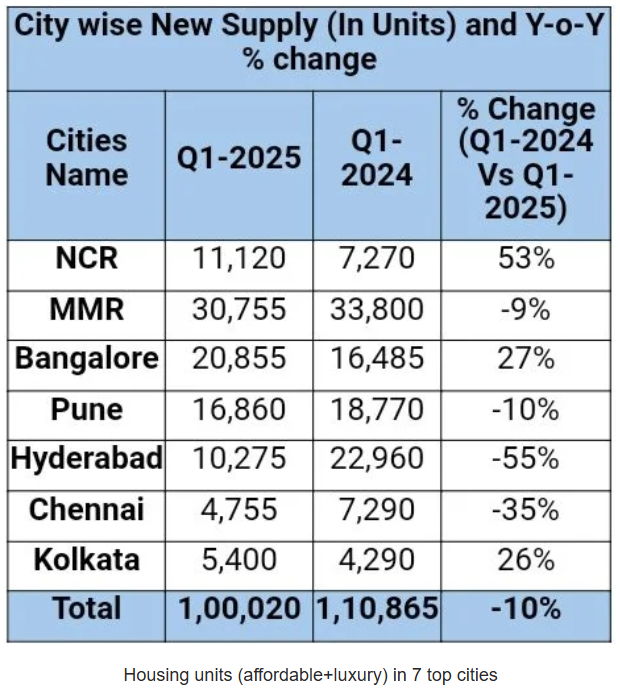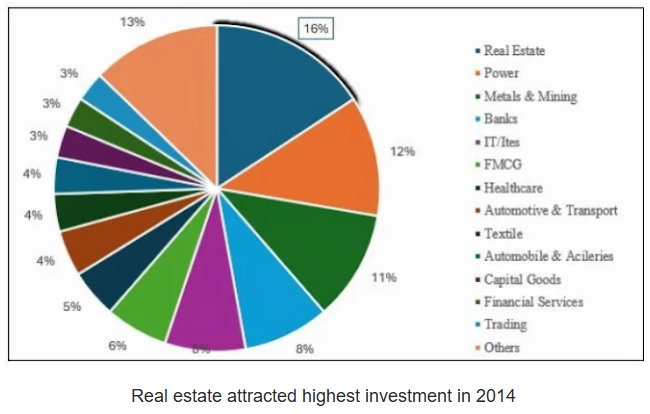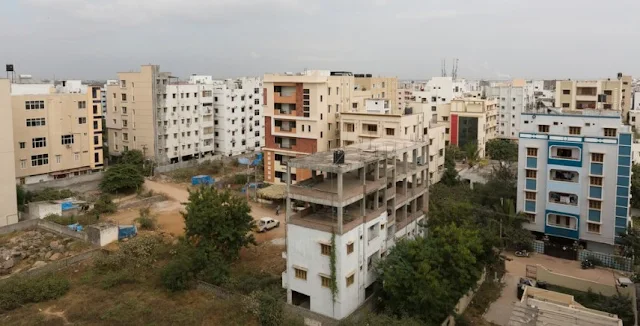A leading property consultant that seeks to provide comprehensive real estate services to developers, corporates, financial institutions, and the government has reported that, while housing prices have risen between 10–34% across India’s top seven cities over the past year, the once-robust supply of affordable housing has “tottered and dwindled.”
In an in-depth analysis of real estate in Bengaluru, Chennai, Hyderabad, Kolkata, Pune, the National Capital Region (NCR), and the Mumbai Metropolitan Region (MMR), in a series of reports it has sent to Counterview as email alert, the consultant Anarock states that NCR and Bengaluru have recorded the highest jumps in housing prices—34% and 20%, respectively.
According to Anarock, average prices in the seven cities collectively have risen from INR 7,550 per sq. ft. at the end of Q1 2024 to INR 8,835 per sq. ft. by the end of Q1 2025. However, at the same time, the annual supply share of affordable homes has declined—from 40% in 2018 to 16% in 2024.
The reason, says Anarock, is that the target clientele of affordable homes, consisting of “blue-collar workers, lower-paid workforces, and those just starting out in their careers, were severely cash-strapped,” leading to a situation where “buying homes did not feature among their immediate priorities.”
According to data released by Anarock, in 2018, cities like Pune, Kolkata, Chennai, and NCR were witnessing a consistently “high supply of such homes, riding on stimuli such as lower GST rates and tax breaks.”
Defining affordable housing as units priced under INR 40 lakh, the consultant comments that, judging by their sagging sales and supply in India over the past few years, now “it is easy to forget that this segment was once the housing industry’s veritable poster child,” which Indian real estate developers took “very seriously, regularly engaging with their architects to design smaller units to contain prices and ensure sales continuity.”
Pointing out that this trend peaked when the Union government in 2015 made “concerted efforts” to promote affordable housing via the ‘Housing for All’ programme under the Pradhan Mantri Awaas Yojana – PMAY (Urban), Anarock says the government at that time announced “many attractive incentives for buyers and developers of such housing.”
In fact, “the affordable housing story took on an appealingly patriotic ‘nation-building’ sheen, and even big-brand developers got into the fray…”

Noting that things changed during the pandemic when the demand for “larger and multi-functional homes with a comprehensive spread of lifestyle amenities” surged, Anarock says the demand shifted to houses that could effectively serve “as both residential facilities and offices… This trend continues even today, and essentially small-sized affordable housing plays no role in it.”
At the same time, it says, “at the developers’ end, constantly rising input costs—comprising land, labour, and construction materials (compounded by the low profit margins of affordable housing and the withdrawal of all relevant fiscal benefits)—caused their previous enthusiasm for affordable housing to dwindle. Instead, they turned their focus to what was and continues to sell well: bigger units with good lifestyle amenities.”
The result is that today, Bengaluru is “devoid of any supply in this segment. Hyderabad and Chennai are seeing only a minimal 2% supply share. The only cities with any sizeable activity in this segment are Kolkata and MMR. In both these cities, nearly 31% of the total upcoming supply is priced below INR 40 lakh. NCR has witnessed a drastic reduction in its share of affordable housing, falling from 62% in 2020 to only 11% in 2024.”
Ironically, despite the sharp downward trend in affordable housing, Anarock research suggests the real estate sector remained a dominant contributor in 2024 in fundraising via qualified institutional placements (QIPs), “both in terms of capital raised and the number of issues.” Notably, 2024 saw twice the number of QIP issues as the previous year. In fact, the sector “recorded the highest number of issues in a single year” in 2024.
However, Anarock regrets, “Skyrocketing residential prices, coupled with geopolitical headwinds, have slowed the Indian housing market’s bull-run in Q1 2025. Latest Anarock data finds that the year’s first quarter saw sales drop 28% across the top seven cities compared to the same period in 2024. Approximately 93,280 units were sold in Q1 2025 in the top seven cities, in sharp contrast to all-time high sales of over 1.30 lakh units in Q1 2024.”
Noting that approximately 93,280 units were sold in Q1 2025—a 26% decrease over Q1 2024—Anarock suggests the main reason for this was, “Average residential property prices across the top seven cities saw a significant jump in the last one year—ranging between 10–34% in Q1 2025 compared to Q1 2024.”
“This,” it insists, “was primarily due to steep new supply additions in the luxury and ultra-luxury segment, and overall strong demand. NCR and Bengaluru recorded the highest annual price jump of over 34% and 20%, respectively.”

In fact, Anarock asserts, private equity (PE) investments in the Indian real estate sector have shown signs of softening. Offering details in its report titled Anarock Capital Flux FY25 Annual Edition, it reveals that PE investment volumes in Indian real estate “have steadily declined over the past five years, dropping from USD 6.4 billion in FY21 to approximately USD 3.7 billion in FY25.”
This represents a 43% decrease from FY21 levels, primarily driven by reduced foreign investor activity amid heightened global macroeconomic uncertainty and geopolitical volatility,” Anarock underlines, adding that this is accompanied by a significant increase in “concentration of capital in fewer, larger transactions.”
Thus, says Anarock, in FY25, the top 10 deals accounted for 81% of total PE investment value, up from 69% in FY24. This spike is largely attributed to the mega Reliance–ADIA–KKR hybrid deal, which alone contributed to ~42% of FY25’s total value.
The “mega Reliance–ADIA–KKR hybrid deal” refers to a financing transaction in which Reliance Industries secured a blended capital infusion from two heavyweight global investors, the Abu Dhabi Investment Authority (ADIA) and Kohlberg Kravis Roberts (KKR), an American global private-equity and investment company.
Stating that “FY25 saw a significant deviation in funding structure, with hybrid deals surging to 42% of total PE capital—primarily due to the Reliance-ADIA-KKR transaction,” Anarock notes that “logistics and warehousing” have emerged “as the clear frontrunner in FY25, attracting 48% of PE funding, the highest in five years.”
As for the residential sector, Anarock says its average deal size dropped to USD 117 million (Q2–Q4 FY25) from USD 233 million (Q1 FY23–Q4 FY25). Offices also saw a “steep decline in investment”—USD 806 million in FY25 versus USD 2.2 billion in FY24.
However, retail “continues to thrive on strong consumer demand,” with mall operators like DLF, Nexus, and Phoenix expanding aggressively.
Courtesy: CounterView

